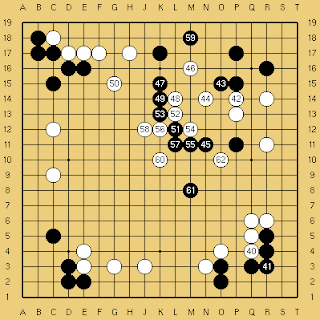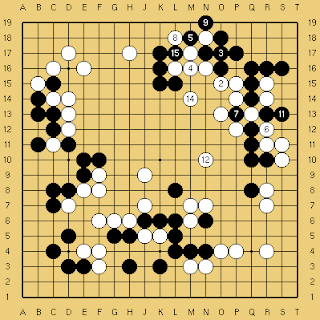Figure 1
76-101
Note: 1=101
White starts by reducing the corner a bit with 76 and 78 and then makes yet another dubious peep at 80. This really is the moral of this game: 'think before you peep'. First black turns at 81 and white runs away with his two weak stones at 82. Then black directly resists the peep buy pushing at 83 rather than connecting. White makes another peep, this one actually a forcing move, at 84 and after black connects white defends the territory on the right at 86. Now black threatens to capture the peeping stone with 87. White manages to pull it out through 96 but this allows black to poke his head out at 91 and connect at 93 in sente. Now black turns back to the center right and captures the two white stones here. I strongly encourage you to see how these two white stones came to be here and how black has succeeded in turning the tables on white. There are some good lessons on peeps and how to resist them in this game. I would also like to point out how well black's two stone sacrifice at H10 and J10 has worked out. White needed yet another move at 100 to firmly capture these stones. If white instead plays at N8 (black 101, or 1) to rescue one stone black will crawl out at 100 and the resulting fight is not very good for white. After 101 black can make two eyes in gote or white can connect at N10 to give black one oversized eye. The downside for white is that even if he does this black has a tremendous number of liberties because of his 5 point eye. It will take white many moves on the inside alone to reduce black's liberties which gives black a huge advantage in future fighting. Though black is not yet definitely alive he has lots of tactical possibilities so the conclusion is that this result favors Shusaku.
Figure 2
102-131
White starts to reduce black's territory and expand his own with 2 through 10. Black 11 is very important. Without it white will play here to seal black into the corner in sente. This will give white a chance to stage a comeback by getting territory in the center. 12 is gote but very big because it has a followup at T3. With 13 black starts reducing the right side. This sequence is pretty easy to understand, black wants to do as much damage as possible while retaining sente and by pushing down to 21 Shusaku makes 23 sente as well. White cannot fight this ko (this is what they would call a 'flower viewing ko' for black. This is a strange phrase but it means that the ko is as pleasant of viewing flowers for black. If white doesn't immediately connect and black starts this ko there is no risk for black so white will not risk this fight no matter how large his advantage in ko threats) so he connects. Black reduces the lower side with 27 and 25, pokes at 29 and then secures a second eye by playing at 31 as you can see in diagram 1.
Dia. 1
Figure 3
132-149
White first plays at 32 which is a good forcing move, ensuring connection and forcing black to connect on the second line. White 34 is very large and sente besides. This is a classic endgame tesuji known as the Monkey Jump and it is required study for intermediate players. Any book with a thorough treatment of tesuji will cover the basics but there can be a great many subtleties in precisely how to respond, both for white and black. White continues in sente with 40 and 42 and then turns to harassing the upper left. After black connects at 49 though it seems that there is no real room to create complications and is behind in the territorial balance. Because of black's deft play and excellent timing in responding to a series of white peeps gave him a solid lead on the board. White resigns after 149.
I thought there were great lessons in this game relating to forcing moves, or kikashi if you want to use the Japanese term, and how to potentially ignore what your opponent thinks is a forcing move. The key is to always be on the lookout to take sente. Every move you should evaluate if you really have to answer your opponents move or if there might be a bigger point somewhere on the board. I hope you enjoyed the review! Till next time, ciao!
















































